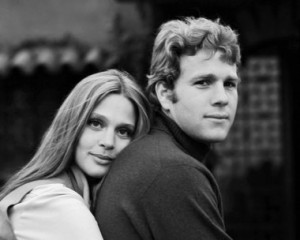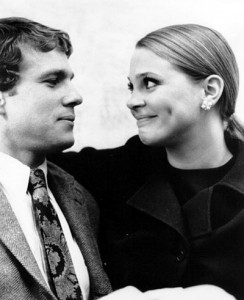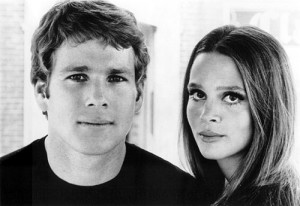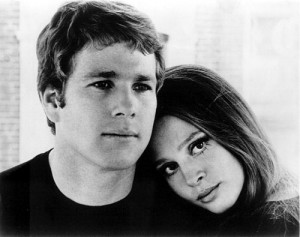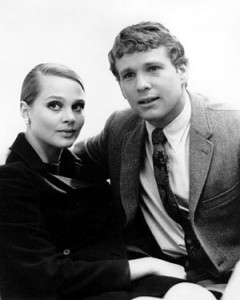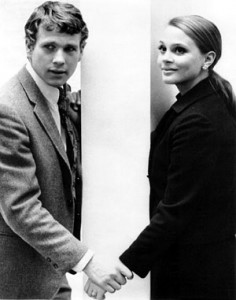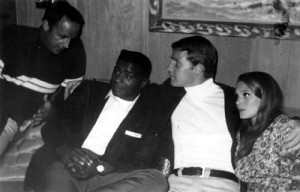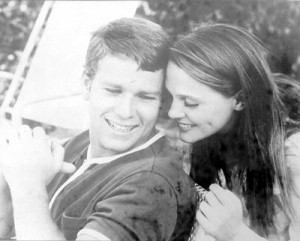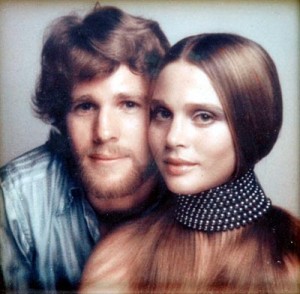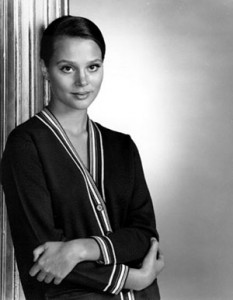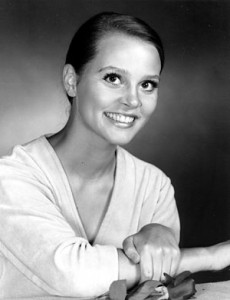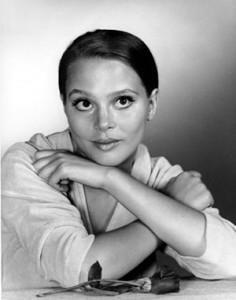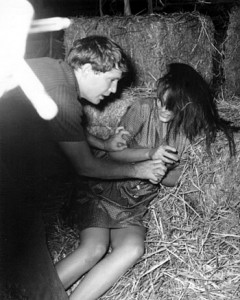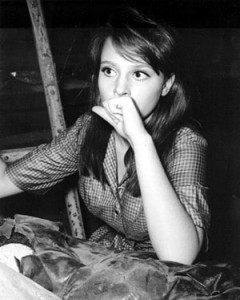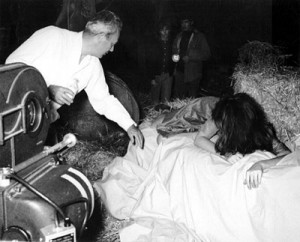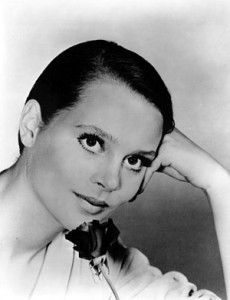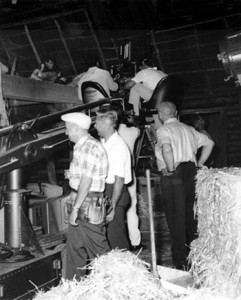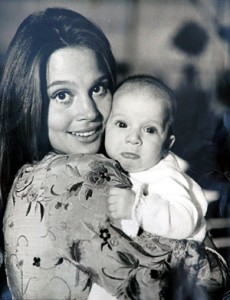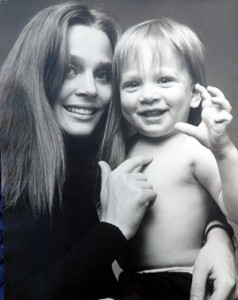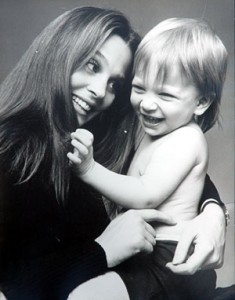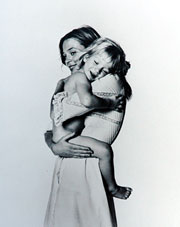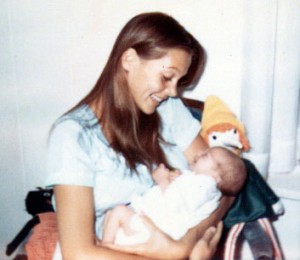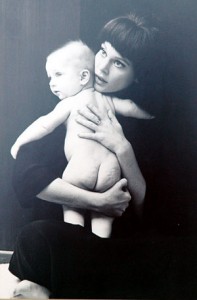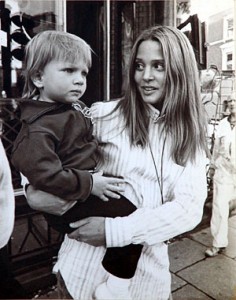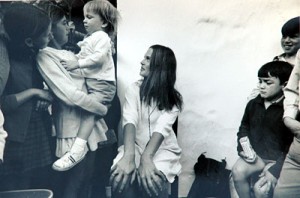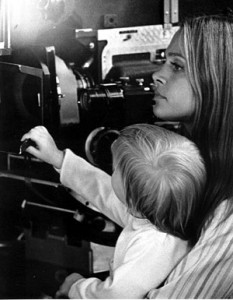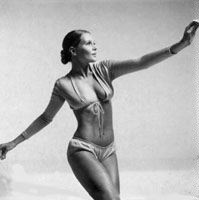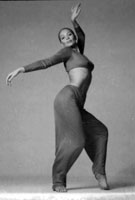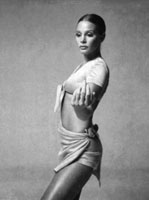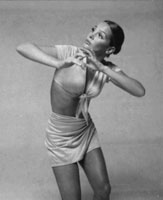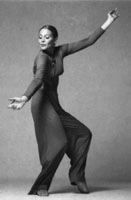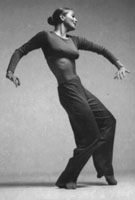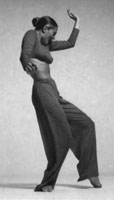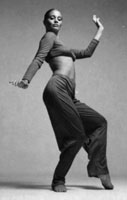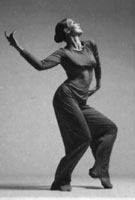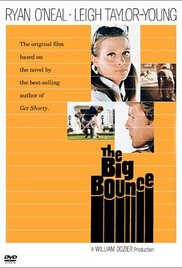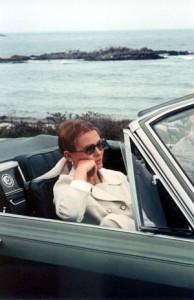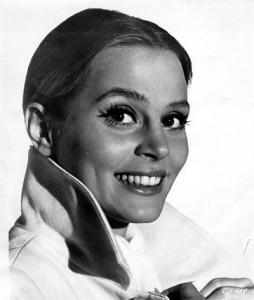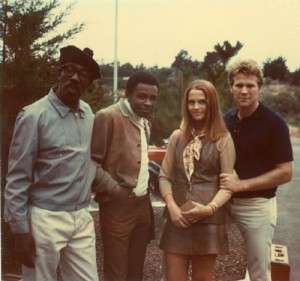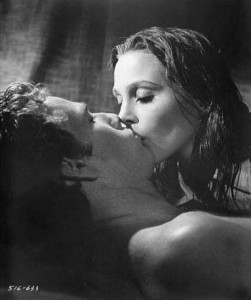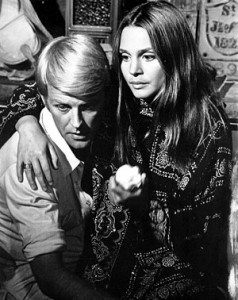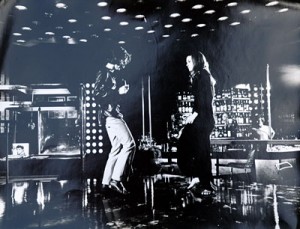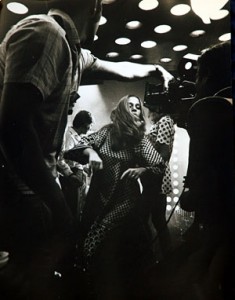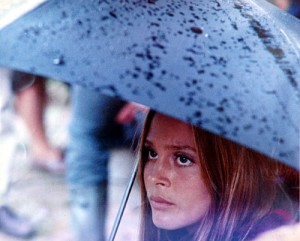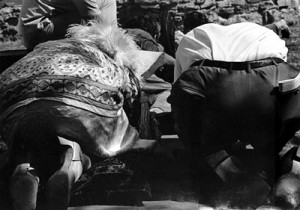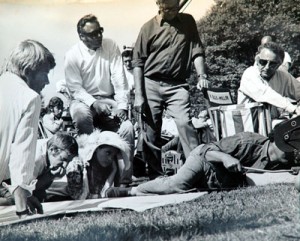In the Sixties, I began a very transformational ten years. In 1960, I was fifteen years old and an extremely solitary bookworm who was just beginning to flower. In 1969, I was a rising young Hollywood star, a mother, and a wife. In between those years, I attended Northwestern University, studied with Sanford Meisner, and debuted on Broadway under Gower Champion’s direction.
I extended my name to Leigh Taylor-Young, and by 1966, I was starring in the television soap opera, Peyton Place. I then proceeded to make five major motion pictures in a row, and traveled all over the world. I married Ryan O’Neal. My first and only son, Patrick O’Neal, was born in 1967. By 1968, I was deeply aware that the culture and social stability I had always known, was suddenly going up in smoke.
Swirling around my awareness and experiences were The Beatles, The Love-Ins in San Francisco, Vietnam, Kent State, the marijuana revolution, mini-skirts, women marching for greater freedom, psychedelic art and drugs, Timothy Leary, Baba Ram Dass, The Maharishi, Ravi Shankar, Bob Dylan, James Taylor, Carol King, Elton John, Cat Stevens, and so on. By 1969, as a celebrity now, I was somewhat used to reading lies about myself in the press on a weekly basis. Also in 1969, I began to explore the alternative healing world of homeopathy, herbs and vegetarianism.
I was initiated into Transcendental Meditation, and began to question my satisfaction in my work, my marriage, and myself. In fact, by the end of the decade, questions filled my consciousness. This state of mind led me to the changes I would choose to make as I entered the Seventies.
1965: New York
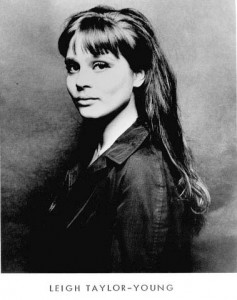
I left Northwestern University in 1964, in the middle of my sophomore year, to return home to Michigan and beg my parents to allow me to go to New York City and study acting with a great teacher. I was on fire, and so passionate and intense about this dream. Nothing else mattered. I needed to express myself as an actress. I wanted to act in all the great plays, and share through the roles my deep feelings about life. I was extremely idealistic, high-minded, and also very shy and non-verbal. Acting answered an inner prayer for a life’s purpose where I could give and express. I was focused only on Theatre. Never once did the idea of a film career engage my mind or desires. It was strictly Theatre all the way. My parents were not happy. They let me stay home to “think about it”.
For six months, I cared for my young sister and brother, cleaned house, cooked, and dreamed about New York. Finally my father relented, and found me a small apartment. They let me go to begin my studies in New York City with the Sanford Meisner, a truly great teacher. Later in 1965, I moved to The Rehearsal Club for young actors ($100 per month for room and board), and continued working with “Sandy”. I was immersed at last in my dream. I lived and breathed all of it. I truly believed if I worked hard enough, I could achieve my goals. When I wasn’t in class, or rehearsing, dancing, or taking voice classes, I was reading Kazanzakis or Teilhard de Chardin, and daydreaming. I had few friends. I was too shy, serious and introspective. I didn’t date or “have fun”. In a sense, I didn’t know how. I simply wanted to keep studying and preparing my dream.
In the fall of 1965, while registering for the acting program at The Neighborhood Playhouse, I connected with a girl I had met casually at Northwestern. She had also dropped out of Northwestern University. Her name was Lucy Saroyan, William Saroyan’s daughter. She was full of energy and talked non-stop. She was so friendly to me, I was delighted and relieved of my shyness by her outgoing and bright personality. She invited me to her apartment for coffee. I was thrilled at the prospect of a friend.
At her apartment later that day, she was bustling about and talking in the kitchen while I sat politely on the couch. At one point, I realized she had asked me a direct question, and I had not responded. I leapt up and ran to the kitchen to answer her, and on the way, I ripped open my left leg on shards of thick, broken glass stacked and hidden under a pile of laundry. My immediate thought was, “Oh no, I tore my stockings,” and I couldn’t afford to do that. My second thought was that this event was an untimely way to start a new friendship. I quickly saw that my leg was cut to the bone. Blood was beginning to flow. Holding my leg together, I asked Lucy for a towel please. I was so calm and polite, she handed me a towel and went on with the coffee. Finally seeing I was still bent over, she asked what was wrong. I said quietly, “I’ve cut my leg”. She then saw the now unstoppable blood, forced me to let her look, screamed, and called her family doctor for the nearest hospital.
We bound me up in towels, and hobbled to a cab that took us to Midtown Hospital. It was a tiny hospital, and for some reason, there were no doctors on duty. There was, however, a Greek orderly who spoke no English who managed to sew me up with 32 stitches. I could legally be given only 10 shots of Novocain in my leg because he was not a doctor. This was a harrowing experience. Lucy was pacing outside the door, calling out nonstop encouragement. This event bonded us into a profound and enduring friendship. I was told by the hospital to do no excessive walking for two weeks. Lucy asked me to stay with her, so I did. She began to skip classes to be with me. Somehow she thought I was interesting. She was utterly fascinating to me. She told me about her life. Her mother was married to Walter Matthau. Her father, William Saroyan, was an American literary legend who lived in San Francisco and Fresno, California. Her godfather was Marlon Brando, and her childhood friends were the Chaplins, the Vanderbilts and the Minnellis. I listened avidly to her stories.
She, in turn, was absolutely certain that I was destined to be a great actress. She felt I should be working professionally at once, and no longer study. She said that she would see to it that I got an agent. At the end of my two-week recuperation, she called her close friend, Jane Elliot (today she is a long standing star of daytime drama), who was 20 years old at that time, and starring on Broadway with Alan King. Lucy asked Jane to do her a favor by giving me a recommendation to audition for Stark Hesseltine, Jane’s agent. Stark was a renowned agent. He had started the careers of many famous and fine actors. He believed in young and talented people, and fought for them often to their great success. His track record for picking “winners” was remarkable.
Jane asked to come over to meet me. She didn’t want any unnecessary competition in the agency. She came over. I never spoke. Once again, I sat politely on the sofa and let them talk. I nodded occasionally. Jane left, assured I was no competition, as I was clearly a mute with no personality! A week later, I auditioned for Stark in a scene from Neil Simon’s Barefoot in the Park. Stark represented the play, as well as its stars, a young Robert Redford and Elizabeth Ashley. Stark was impressed and excited with my audition, and signed me that day. Within a week, I was going out to audition for major plays. Six months later, I was cast as the ingenue lead in a Broadway comedy directed by Gower Champion. The play was called Three Bags Full. This was Gower Champion’s first non-musical. His previous great success was Hello Dolly.
I now had to join Actors Equity, the union for stage actors. This meant I had to choose my professional name. My birth father’s last name was Taylor, my second father’s (or “stepfather”) name was Young. I wanted to honor both these men that I loved. I became Leigh Taylor-Young. However, I did think then that no one would hire me, with such a long, hyphenated name. This proved not to be the case. My professional career began as Leigh Taylor-Young in the spring of 1966, with my Broadway debut in Three Bags Full.
1966: Meeting Ryan
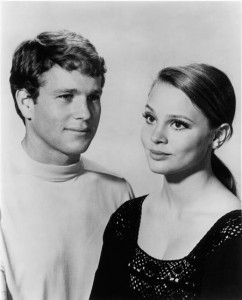
In the spring of 1966, Three Bags Full, a comedy starring Paul Ford, Nancy Marchand, and myself, closed on Broadway. There had been a severe transit strike, and too much loss in ticket sales had occurred due to the lack of transportation in the city. I was disoriented. I was now out of the two-year Neighborhood Playhouse program, and I had no job. The first experience of the “next job insecurity” that affects every actor, hit me hard. Within a month of the plays closing, I had developed pneumonia, probably from the stress of no apparent work. I ended up in Doctors Hospital to recover. While there, I read of a spa in Palm Springs. It appeared to be a health retreat and a place to heal. I called a travel agent to order tickets to Florida. The agent said, “I’m sorry, Palm Springs is in California, not Florida”. I was taken aback. California, what a romantic and faraway place! It seemed much less accessible to me than Florida. I took a risk and said, “All right, I’ll take a ticket to California”.
Within a week, I was in the Palm Springs Spa, run by Anne-Marie Bennstrom, who today owns and runs The Ashram Health Retreat. It was a wonderful place for me and a revelation. There were palm trees, penetrating heat, non-stop clear skies and sunshine, and my first “organic food”. I stayed three weeks instead of one. I had not told my agents I had even left New York City. I did love to disappear occasionally and go where no one could find me. I found that a peaceful, private, and liberating thing to do. I always felt more enriched in myself when I would return. In the third week at the Spa, I finally called my agents to tell them where I was. Stark Hesseltine, my primary agent, said, “You must go to Los Angeles on your way back to New York, meet my West Coast partner, and have some meetings with casting agents and producers”.
I was very reluctant to do this, as I was absolutely clear that Theatre was all I wanted. However, I respected Stark greatly, and I wanted to be an agreeable client. I went to Los Angeles and met with Wally Hiller, a delightful man and agent who immediately set up various meetings. I was innocent and unknowing of how the film and TV industry worked. I enjoyed going here and there for meetings, and didn’t take any of it very seriously. I was looking forward to returning to New York and preparing for the fall auditions in the Theatre. On my third day in Los Angeles, Wally told me I would be meeting the producers of Peyton Place. Peyton Place at that time, in 1966, was in its second year of being a television phenomenon. It was the first American night-time soap opera, and the country was mesmerized by it. It was based on the book, Peyton Place by Grace Metalius. This book had been, in its time, America’s “raciest” novel. The television show, of course, could not be so sexual, but the resonance from the book’s reputation lent a tone of the “forbidden” to our show. It was an ensemble cast of young and beautiful actors who were supported by many fine character actors and former film stars. The predominant young stars were Ryan O’Neal, Mia Farrow, and Barbara Parkins. The older stars included Dorothy Malone, Dan Duryea, Lee Grant, and many more.
The younger actors had all become stars, and filled the movie magazines. I had never seen the show. I had either been working nights in my play or had been in school. So, when I walked into this meeting, I was relaxed and fairly unknowing. Those present were Paul Monash, Ernie Chambers, Wally, and myself. I remember having a feeling that something was about to change. There was an excitement in the air. I don’t know, in looking back, if these were premonitions, or simply an attunement to what seemed to be an enthusiasm for me on their part. I cannot explain why they were so receptive. It was just a meeting. They were, however, actively looking for a young actress to replace Mia Farrow, who had left the show quite suddenly to start a new life with Frank Sinatra. They asked if I would come back in a few days and do a scene from The Glass Menagerie by Tennessee Williams. It meant a delay in my return to New York, but Wally Hiller assured me that it was important. I immediately began working with an actor-client of Wally’s to prepare the scene. We did it for the producers, and again, this sense of excitement was present.
I was now very ready to go home, and said so, strongly, the next morning to Wally. He said, “Well, I have news for you. The producers want to give you a screen test”. This was my first exposure to the system where first the deal is made, then the screen test. This gives maximum leverage to the employer. I did not want any part of it, especially when I heard the contract was for seven years. This horrified me. It meant that if I did the audition, and they loved it, automatically the contract would be in effect. I was so stubborn and resistant about it that Stark called my mother in Detroit to get her assistance. Mom called me. She reasoned that even if I was under contract and used for the full seven years, I would still be young, only more experienced. I would also be financially secure enough then to choose back into a career in Theatre. She helped me step into the adventure that was being presented to me. I agreed to the test and began to prepare myself.
The screen test was scheduled in the middle of a Peyton Place shooting day on Stage 9 at Fox Studios. My makeup for the test was put on by an old “codger” of a makeup man everyone called “Shotgun”. I later learned he was very famous and worked almost solely with Frank Sinatra. The makeup area was on the open stage, which looked like a large cavernous warehouse with different interior “sets” of the town of Peyton Place. There were bedrooms, living rooms, kitchens, and the interiors of Peyton Place stores. I remember how real they all looked. During my makeup, I saw several of the young stars of the show coming to the stage. One came up and said, “Hello.” He was cocky, very sure of himself, and said something encouraging to me. I recognized him as Ryan O’Neal.
I was then taken to a living room “set” and sat on a couch. The actor I had worked with on the scene was brought in and sat next to me. I saw a huge machine called a 35 mm film camera, with a man riding on it, moving towards me. Lots of men were moving big lights and placing their focus and attention on me as if I were an object. The large camera looked ominous as it set its position. The lights came on, and I saw just behind the camera eight chairs placed in a semi-circle. All the young Peyton Place stars were gathering to sit and watch my screen test. Somehow the word about me was out amongst the cast, and they wanted to see me work. I was not only adjusting, on the spot, to a whole new mechanical environment of camera, lights and crew, but now all the stars would be watching. The director of my test introduced himself as Jeffrey Haydyn. He explained what was going on. I must have looked like a “deer in headlights”, and I felt like one.
When the moment came to begin on “action”, I had already gone deep inside to a place where I was centered in the character’s life. Everything went so silent as the scene was shot. When it was done, Jeffrey put his arms around me and seemed very pleased. I felt like I was in an altered state. The next day I was told that I would begin as a regular on Peyton Place in the character of Rachel Welles. I had a month to return to New York, gather my things, and move to Los Angeles to begin a new career in television.
This photo of Ryan and myself was taken in the first week I started filming, late August of 1966. It was my first photo shoot. I didn’t know Ryan at all, other than as a television star and a movie magazine “man about town”. They had me photographed with each young star, as I was readied by the Fox press department to be presented to the public as a new resident of Peyton Place. To say that life mirrored art would be trite, but I would have to admit that very soon, my life did take on the aura of the unreal. I soon became one of these young stars, and my relationship with Ryan began, which would alter my life.
LTY and Ryan
- TV executive Tom Tannenbaum, World Heavyweight Champion Floyd Patterson, Ryan O’Neal and LTY September 1967 (LTY 9 months pregnant with son Patrick)
Peyton Place Moments
- Peyton Place Photo by Erik Madden
- Peyton Place Photo by Erik Madden
- Peyton Place Photo by Erik Madden
- LTY With Christopher Connelly (Norman Harrington)
- LTY as Rachel Welles
- LTY With Director Walter Doniger
- LTY as Rachel Welles
- Peyton Place First day of Shooting
- LTY and Ryan
1967: My Son
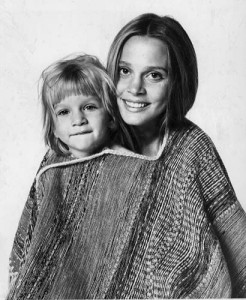
September 14, 1967 was the day my son was born. I was convinced throughout my pregnancy that I would have a girl. I believe I felt that way because I was, at that time, very “soft” internally, extremely sensitive and vulnerable, and I had reached my level of tolerance for “changes”. In the year prior to his birth, I had my first love affair, with Ryan, and had become a major television star where my anonymity and privacy had gone forever. I had married a very volatile and temperamental man who didn’t seem prone to fidelity. The security of my contract with Fox studios was in the hands of “randomnicity”, or so it seemed. My life was in a state of flux. I had worked on Peyton Place until my fifth month of pregnancy. They wrote my character, Rachel Welles out of the show, by having her lose her mind and be sent to a sanitarium.
I was now free to enjoy my pregnancy without worrying if my stomach showed, or if I would be able to make it to the restroom in time between shots to throw up. Ryan and I had married in my third month. I adored Ryan. Actually, it was more of an infatuation, as I had married someone quickly who I barely know as a person. We rented a beautiful house in Benedict Canyon that had been the home of Humphrey Bogart and Lauren Bacall. It was the perfect place to have an enchanted pregnancy. There was a pool under trees, deer, roses everywhere, and a lovely tennis court. Ryan did me a great favor, he worked me out every day of my pregnancy. Sometimes he would have me run against a time clock, or simply have me run up and down the long driveway of our home. I started tennis lessons in my fourth month, and was playing the day Patrick was born.
The night Patrick was born, Ryan was watching “Thursday Night At The Fights”, a television boxing extravaganza that was ritual TV fare in Los Angeles in 1967. A boxer, Young McCormick, was fighting that night, and Ryan favored him. I was almost three weeks overdue. It was a hot September night and I was cooking dinner. I felt my first contraction while cooking, and two minutes later there was another. I served Ryan his dinner, sat down, said nothing and waited to see what would happen next. My contractions remained two minutes apart. We raced to the hospital. Patrick’s birth came quickly. I had only one hour of labor.
I watched the birth with great excitement, and when I was told it was a boy, I said spontaneously, “How am I going to raise a boy alone?” It was clearly some deep, intuitive knowing of the future that came out of my mouth in those extraordinary moments. To my conscious mind, I was still very married.
Because I had been so sure I would only have a girl, I had chosen no names for a boy. Ryan became intent on naming the baby “Rocky O’Neal”. I suggested the name Patrick, as a compromise, as that was Ryan’s real first name. Ryan agreed, but wanted to add the name Young to Patrick O’Neal in deference to the Irish boxer who had been fighting that night. So Young Patrick O’Neal made his entrance, and blessed my life. By 1970, Patrick and I were on our own, and we became deeply bonded by all the experiences that can happen between a working single mother and a little boy. The “normal” family structure was not to be ours. We had to become very flexible and adventurous to make our special journey together work for the highest possible good. Today he is a successful on-camera sportscaster. He and Rebecca De Mornay have two beautiful daughters, Sophia and Veronica. The girls are fast growing into unique and very loving individuals because of their loving parents and who they are already as souls. This sweet photo of Patrick and I was taken by a great photographer, Bill King, for Vogue in 1969.
LTY and Her Son Patrick
1968: I Love You Alice B Toklas!
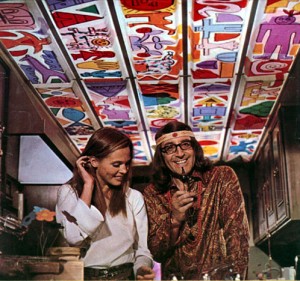
In 1967, I was released from my seven year contract with Fox Studios, where I was starring in Peyton Place, the first television nighttime soap opera. Peyton Place was a national phenomenon at that time. I had just turned 22 and was newly pregnant. Ryan O’Neal was the father.
Ryan was still married to Joanna Moore, an actress, but had been living separately for two years during which time he had become a very publicized Hollywood “playboy”. He was my first love, and it proved to be a very difficult and life changing one. However, the greatest blessing came from it, my son, Patrick O’Neal.
Two weeks after Patrick’s birth, I was informed by Fox that my contract was dropped due to the option they held, called “The act of God” clause. This meant the studio had the right to determine whether my nine months off work for my pregnancy was in the best interest of the show. They decided it was not, and my contract was terminated. This depressed me. I was delighted with my new baby, however I still wanted my work as an actress.
That very same week a close friend of Ryan’s came to play tennis with us. He was a producer, and he told me there was a movie at Warner Bros. starting production almost immediately starring Peter Sellers. It was called I Love You Alice B. Toklas. Evidently, they were desperately looking for a young new talent to play the hippie girl in the film. Our friend said it was a terrifically funny comedy, and that he could help me get an audition with the producers. Several days later I got the script, and it was indeed very funny. I was nonplussed by the character of “Nancy”.
Although it was 1967, I felt very removed from the hippie phenomenon. I had been working non-stop for two years as a professional actress with a heavy schedule. My focus had been my career. I had never said “groovy” in my life, or worn a short skirt, or smoked anything at all. In fact, I was still wearing little white gloves, stockings and long skirts. I loved only classical music, didn’t drink or swear, and was still a virgin at 21.
In I Love You Alice B. Toklas, “Nancy” was a free-spirited character who said “groovy” a lot, smoked grass, and sex was where and when she chose it. Everything was experienced in a haze of delight. She also had a tattoo high on her thigh of a big Monarch butterfly. Needless to say, I was worried. I had no personal reference points for this character. Ryan was helpful. I had no idea what getting “high” was like. He suggested pretending that I was listening to a favorite symphony in my head while saying the dialogue. This would give the impression of being spacy and “high”. It was a great key for me.
We drove to the audition at Warner Brothers on Ryan’s new Harley Davidson motorcycle. I wore the closest thing I could to a hippie outfit. It was a short, leather tunic without the long pants, sandals, and bare legs. My hair was very long and straight; I let it flow. My body had rapidly regained its slenderness, and I was very tanned from swimming during the pregnancy. I had not known that Peter Sellers would actually be there, but he was. I was terribly shy then, but I was warmly greeted and put at ease by Paul Mazursky and Larry Tucker, the brilliant writers of I Love You Alice B. Toklas. I was taken into another office where I began reading a scene with Paul Mazursky. Peter watched. There was an energy of excitement in the air. I had an odd sense that my life was changing. After I read, Peter asked if he could photograph me. He placed me by a window and began to shoot. They all seemed excited and happy. I left. Later that same day, our producer friend called and said it looked incredibly good for me. The next day, I was told I’d begin shooting in two weeks.
Making I Love You Alice B. Toklas proved to be a life experience rich with stories to tell. My agent soon became Freddie Fields, a truly legendary agent in Hollywood’s history. I was starring opposite Peter Sellers, a comic genius who fell in love with me and complicated my personal life with his attempts to deal with my devotion to Ryan. I smoked my first joint on camera having been told it was only oregano. It was the first contemporary movie where smoking joints, making marijuana brownies and getting “high” was explicitly and very humorously demonstrated. I Love You Alice B. Toklas became a cult classic of the Sixties and launched my film career.
I Love You Alice B. Toklas – Gallery
1968: Andy Warhol
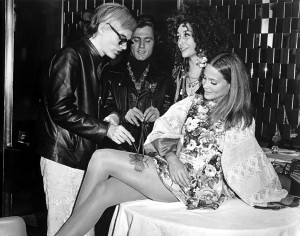
The week I Love You Alice B.Toklas premiered in 1968, I was immersed in press interviews to promote the movie for Warner Brothers. Warner Brothers threw a big cocktail party to introduce me to the press as the new young star of I Love You Alice B.Toklas. To give a tone of the “avant garde”, Andy Warhol was invited to attend with his colorful entourage. It was the first time that I would meet Andy. Several years later, while making The Gang That Couldn’t Shoot Straight, I would begin to “hang out” with Andy, his entourage, and especially with Gerard Malanga, a poet who was always by Andy’s side. This however, was an evening focused on me and my film debut.
I arrived with my press agent and a Warner Brothers’ representative. This was a new experience for me, and very exciting. There were flashbulbs popping and an enormous amount of attention and focus on me. I had been getting used to “attention” since Peyton Place and my high profile relationship with Ryan O’Neal. However, the energy of this particular evening carried the excitement of the discovery of a new star in her own right. I was led to meet Andy Warhol, and he suggested that he paint a butterfly on my thigh for the photographers. Everyone loved it, as the photographers flashed away. It was a truly “Sixties” moment with Andy Warhol, and the film epitome of the Sixties flowerchild.
Learn More About Andy Warhol
1968: Avedon
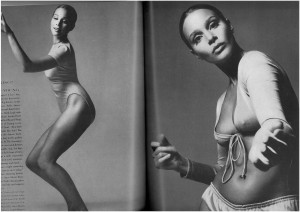
As an emerging young actress in 1968, I now had a top press agent named Rupert Allen. He was older, and a very cultured and respected West Coast press agent. He was also a close friend of Princess Grace of Monaco. He was a kind and intelligent “guide” for me. I needed it. A lot was happening. I now had all the attendant people for a “rising young star”, a press agent, an agent, a business manager, a nanny, and an assistant. I was 22. I also had a new husband and a newly born baby.
On one New York press trip, it had been arranged for me to be photographed for Vogue by Richard Avedon. Polly Melon directed the photo shoot for Diana Vreeland, the editor of Vogue. This was a new experience for me. I was scared. I had always been uncomfortable about having my picture taken. I didn’t understand it then, later I did. I didn’t feel safe unless the photographer was “with me”, cared about me even, or was simply attuned to me. I didn’t know Richard Avedon personally. I did know, however, that he was a master amongst photographers. His work was awe-inspiring to me. I did not feel very confident that I could give what would be needed in such a shoot, as I was still very introverted. However, genius that he is, he quickly realized I was a dancer. He put on music that I loved, from classical to very primitive drums, and encouraged me to move.
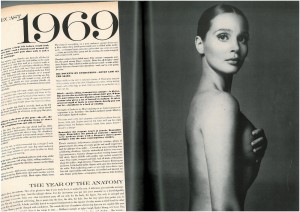
Something truly extraordinary happened. I actually felt like I was on some kind of drug. As I danced, I began to open up and free some very deep inner emotions. Before his eyes, and his camera, I felt like I became many women, as I moved to the music. He recognized it, and probably played a part in it, simply by his gentle encouragement and his unique, powerful, yet subtle presence. It was as if we danced together. It was a very creative and intimate experience that felt very empowering. I literally felt as if I uncovered parts of myself to myself, with his eyes and camera as my permission. It was the most satisfying creative experience I had had, in many ways. It remained a reference point for me of my emerging self. The photos were in Vogue in 1968, and they received tremendous reaction.
LTY by Avendon for Vogue
1969: The Big Bounce
Starring Leigh Taylor-Young and Ryan O’Neal.
Synopsis: A Vietnam veteran and ex-con is persuaded by a shady woman to rob a $50,000 payroll account on a California produce farm. But who is playing who?
FILMING the Big Bounce
1969: The Buttercup Chain
Starring Leigh Taylor-Young, Hywel Bennett, and Jane Asher.
Born to twin sisters on the same day in London, France and Margaret are more like brother and sister than cousins. The close relationship between the cousins is suspended when Margaret is sent abroad for schooling. Now a young woman, Margaret returns to London and resumes her intimate connection with France. Fearing that their relationship could become incestuous, France decides that he and Margaret should take lovers, and chooses Fred, a Swedish architectural student, to be his cousin’s lover. For his mistress, France picks Manny, an American who has had many lovers. The foursome spends a romantic summer interlude at an estate in Spain, where Margaret beds Fred while France takes Manny. Once back in London, however, Manny senses that France is in love with Margaret, and begins to suspect that he is using both Manny and Fred to suppress his own feelings. To spare the unsuspecting Fred, Manny seduces him. Upon discovering that she is pregnant, Manny is uncertain about the paternity of her baby, but nevertheless names Fred as the father. Manny’s former lover, a middle-aged millionaire named George, offers to throw Manny and Fred a lavish wedding reception, but when Manny gives birth on the day of the reception and is forced to miss the celebration, Margaret and France find themselves the sole attendees. Following the wedding and birth, the four friends decide it is best to end their close relationship, and so Fred takes Manny and their baby to live in Sweden, while Margaret leaves for Rome to study art, and France stays behind in London. Some time later, Margaret returns to London after the end of a disastrous love affair, and France suggests that they visit Fred and Manny in Sweden. There they find that Manny and Fred are trapped in an unhappy marriage. Fred, who is still in love with Margaret, takes her on a tour of Sweden while Manny and France rekindle their love affair.
FILMING the Buttercup Chain
- The Buttercup Chain – Director Robert Ellis Miller watches as LTY and Clive Revill provide eyelines
